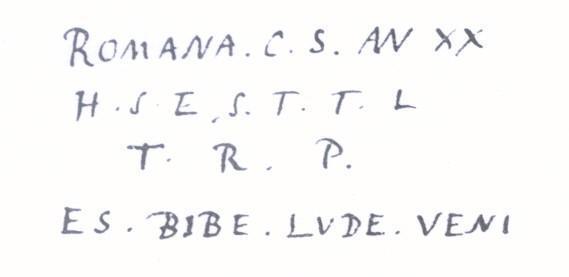Epitaph of Romana
Reference CIL II 1877 | Description | Lyrics | Location | Chronology | Epigraphic edition | Translation | Apparatus | Comentary | Type of verse | Text divided into verses and metric signs | Images | Bibliography | Link to DB | Author |
Epitaph of Romana
Description
- Idno filename 22/01/0065
- Type of inscription: Sepulcralis
- Perdida
Location
- Place of discovery: From Cádiz. Lost.
- Geolocation
- Location with Modern Nomenclature España / Cádiz
- Location with Old Nomenclature Hispania / Baetica / Gaditanus
Chronology
- Inscription's dating: Between year 70 and year 130
- Dating explanation: The formula c(arus) s(uis) establishes a terminus post quem of the end of the 1st c. AD - beginning of the 2nd c. AD, cf. STYLOW 1995, 223.
Type of verse
- Type of verse: Dactílico (pentámetro)
- Verse/line correspondence: No
- Prose/verse distinction: Si
Epigraphic edition
Romana c(ara) s(uis) an(norum) XX
h(ic) s(ita) e(st) s(it) t(ibi) t(erra) l(evis)
t(e) r(ogo) p(raeteriens)
es bibe lude veni
Text divided into verses and metric signs
Te rogo praeteriens: es, bibe, lude, veni. lkl|lkk|l||lkk|lkk|~
Translation
“Romana, loved by her own, twenty years of age, is buried here. May the earth rest lightly on you. I beg of you who pass by: eat, drink, be merry, come”.
Bibliography
Anonymvs, BCC, ms. 60-1-13, 282; Concepción 1690, 115 (inde Clemente 1846, 78 n. 126; Hübner, II 1877 [inde Bücheler, CLE 1500, cuius exemplum in linguam Hispanicam vertit Fernández Martínez 1998-99; Cholodniak 1904, 1216; Cumont 1928, 83; Romero de Torres 1934, 182; Vives, ILER 3800; González Fernández, IRCa 273; Ferreira 1996, 121]); ex eis Gómez Pallarès – del Hoyo – Martín Camacho 2005, 243–250; Martín Camacho, CLEB ES, CA4, qui in linguam Hispanicam vertit; Cugusi 2012, 57. – Cf. Purdie 1935, 37; Bömer 1963, 1084; Kajanto 1969, 363; Sanders 1991, 457–458; Hernández Pérez 2001a, 266–268; Martín Camacho 2005, 714–715.
Apparatus
2 s(erva) BÖMER, ann(orum) CONCEPCIÓN. – 4 te rogo praetereuntem? BÖMER in apparatu. – 5 lud CONCEPCIÓN.–
Comentary
Pentameter made up of two formulaic expressions. The inscription contains the formulaic repertoire characteristic of the province of Cádiz plus an invitation to enjoy life. The ordering of these formulae distinguishes this inscription from the others of the province: t.r.p. and s.t.t.l. have inverted their order to s. t. t. l. t. r. p. Thus, t.r.p. is not joined as usual to s.t.t.l., but instead introduces es, bibe, lude, veni. Therefore, an attempt is being made in the epitaph to be original, to manifest poetic intent. L. 4, es bibe lude veni, resumes the topos of the enjoyment of pleasures as a reaction to the arrival of death, cf. MA1, CO12 and BA15; and in known authors, cf. Liv. Andr. carm. frg. 41 (ed. Morel 1910); Plaut. Mil. 677; Hor. epod. 2,2,214-5 and Varro Men. 87 (ed. J.P. Cèbe, 1972). L. 4, the imperative veni does not transmit obligation, but rather the inevitability of death, expressed at other times by a periphrastic passive, cf. CLE 1097,5; CLE 83,4; etc.
Author
- Author:J. Martín Camacho
- Last Update2023-11-21 13:26:36
You can download this





